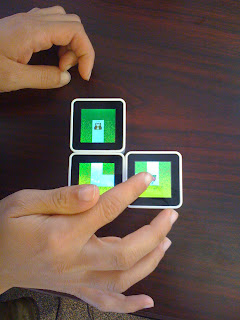Eighteen days into the SmallBox #ThinkKit11 challenge. Didn't know I could do it for this long or not, but here we are. One week from today, we are with our families, enjoying good food, and mostly, playing with our new gadgets and gizmos Good Ol' St. Nick brought us ... or at least what our credit cards burned a hole in our pocketbooks on.
Sunday, Dec 18: Technology
What technology changed your world this year? Pick a gadget, a website... how did it make a difference for you?
Sunday, Dec 18: Technology
What technology changed your world this year? Pick a gadget, a website... how did it make a difference for you?
While I was in Chicago on the failed contract-to-hire, one of the managing directors asked a colleague and I to take a look at some cool gadgets for usability and user experience, so that a blog entry could be created accordingly. So, in essence, he bought us some games to play with. Now, I'm a gamer - I always have been. Beginning with an Atari 2600 and coin-op games, I've enjoyed the hand-to-eye combat with forces of evil in digital format, whether they are aliens, bad guys, or other drivers in the same game. However, let's be honest, some of these games aren't very educational, or if they are, they are very limited in their expansion.
One game that was given to us to review was Sifteo Cubes (http://www.sifteo.com). They are three cubes, each with an LED display, that allow a user to physically manipulate the cubes in a certain way, whether they are shuffled, flipped, tilted, spun around, whatever. Game play is done completely through the cubes themselves, to which the only additional needs is a laptop computer and a free USB port. Games are downloaded (free or by purchase) using Sifteo's homespun application (think iTunes). Each of the cubes' LED displays also doubled as a clickable "button", so if there was an action that was needed, press the LED itself!
 |
| Sifteo Cubes |
Now, when we were turned loose to play with them and try to write a blog entry, one of the things we started thinking about was the overall audience? Who would really play with these, and how would they play with them? In my opinion, I could easily see my 6-yr-old niece playing with them, as she's at the right age for educational games. However, my 9-yr-old nephew ... meh ... I think he'd probably play with them in their current state as more of a novelty game, but I'm not sure he'd play with them for extended periods of time.
At the time of Sifteo Cubes release, there weren't many games just yet. The one game that keeps me thinking was a maze game, whereby a gopher would need to traverse a maze to find a turnip, but you had to manipulate the cubes so that you could move the gopher further in the maze. It forced you to have spacial thinking about something as simple as a maze, which is brilliant, in my opinion. One other game that stood out was an ordering game, where you had to maneuver the cubes into a certain order (such as A - B - C) as quickly as possible. That might not sound hard, but people could set up their own matching game, and give them to their children, perhaps as a learning tool for a particular subject they may be having difficulty with. For example, could you quickly put these in the right order: Taft-Harrison-Coolidge ... makes you think on the fly doesn't it?
Alas, there were some concerns we had. First was the overall cost for the starting system: $150!! For 3 of these cubes (each about 1.5" square), a transponder to go into the USB port, and a charging station. You could buy an additional three cubes for $45 each - meaning for the whole 6-cube set, it would set you back almost $300! Crikey! And for a game system that (at the time) I targeted only for 2nd Grade and below. There were only a limited number of games ... guessing 10-15 at the time ... and only a handful of development companies that were starting to take on designing & building Sifteo games. All sounds were played through the laptop computer, not through internal cube speakers, which is odd knowing today's available technology. And, you were required to have the computer running at all times. The cubes were "tethered" to the running computer, so you couldn't download a game to the cubes (using the cubes' flash memory), then take just the cubes on a car ride. No computer - no fun.
In fairness, could I see someone actually purchasing the cubes? Yes! Elementary schools might consider purchasing them, so that the systems remain in the K-2 grade range. Educators could really capitalize on their utility as a supplementary learning mechanism that kids of that age group could really find fascinating - and that's what school districts need to uncover ... how to make learning fun again. Too often, we hear of regimented educational programs that, while powerful, churn out unhappy kids. Kids like to play video or computer games, so why not capitalize on this idea in the classroom!
Do I see potential for other opportunities? Sure. As my colleague presented, I could easily see an electrical engineer designing a new circuit board using these. I can see a budding D.J. mixing complex music beats. I can see an artist trying new colors for digital imaging. I could see uses in fashion, in media, in sports. The mind begins to really think about the possibilities in education, especially those in the middle school and high school levels. Even in those programs having special educational needs.
It never hearts to dream about possibilities, and what might come.
No comments:
Post a Comment